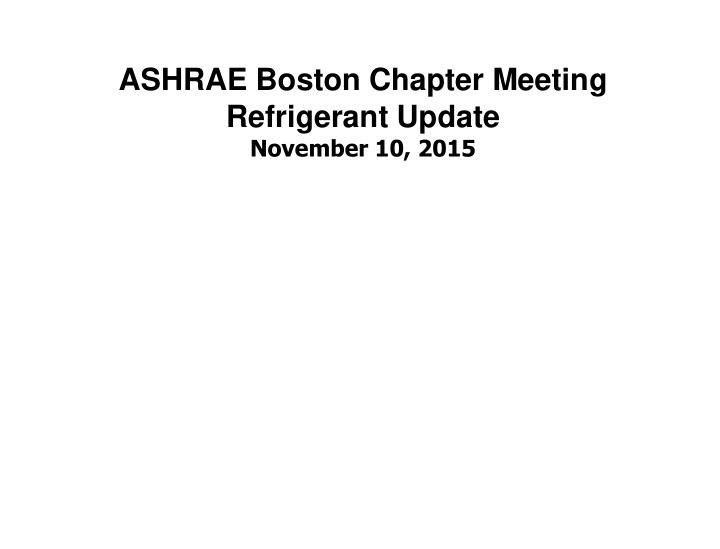



ASHRAE Boston Chapter Meeting Refrigerant Update November 10, 2015
Outline • Refrigerant cycle- 10 minutes • Ozone depletion- 10 minutes • Global warming- 5 minutes • Refrigerant terminology- 10 minutes • Temperature glide- 10 minutes • Refrigerant phase-out- 5 minutes • Review of EPA SNAP form- 10 minutes • Quiz and Questions- 5 minutes
Basic Refrigeration System • Air-cooled • Water-cooled • Evaporative Condenser Compressor • Scroll • Reciprocating • Helical rotary (screw) Metering Device • Centrifugal • Capillary tube • Orifice • TXV • Level control Prime Mover • Electronic • Motor • Engine Evaporator • Steam Turbine • Air cooling coil • Shell & tube (liquid chiller) • Special (process)
Basic Refrigeration System E+Q out Condenser Metering Device Compressor Evaporator E in Q in Typically 30% of Q
Basic Refrigeration System 100°F-195 psi Condenser Metering Device Compressor • Capillary tube R-22 • Orifice • TXV • Level control • Electronic Evaporator 45°F- 76 psi
Ozone Depletion • Bad Ozone - Tropospheric - 0 to 7 miles above Earth • Good Ozone - Stratosphere - 7 to 30 miles above Earth • Tropospheric Ozone – Caused from sun acting on air contaminants causing smog • Stratospheric Ozone – Filters ultraviolet rays UV shielding – Earth of ultraviolet radiation, fortunately, 90% of ozone is found here – Types of radiation • UV -A - not harmful • UV -B - harmful if not filtered in stratosphere • UV -C - not harmful
Stratospheric Ozone Depletion
Montreal Protocol’s Positive Impact on Ozone Hole Ozone hole still large, but healing; full recovery expected ~2070 Source: NASA. Image from Nov. 2, 2014
Global Warming
Desired Refrigerant Properties Environmentally Acceptable Non-toxic Non-flammable High latent heat of vaporization Chemically stable Material of construction compatible Lubricant soluble Low moisture solubility High dielectric strength Ease of transport handling Capable of recycling Detectable at low concentrations Reasonable cost Readily available Field system charging capability
REFRIGERANT ACRONYMS • CFCs - Chlorofluorocarbons – Atmospheric Life of 75 to 120 years – High ODP (Ozone Depletion Potential) – CFC-11, 12, 113, 114, 115 (and many more) • HCFCs - Hydro chlorofluorocarbons – Have shorter atmospheric lives – Less chlorine than CFCs – HCFC-22, 124, 123 • HFCs - Hydro fluorocarbons – Have shorter atmospheric lives – Have "zero" ozone depletion potentials – Contain no chlorine atoms – HFCs are: HFC-134a, 152a, 125, 143a, 32
Azeotrope vs Blend • Azeotrope- a mixture of 2 or more refrigerants that act as one – One boiling and one condensing temp – Example is R410A • Blend- a mixture of 2 or more refrigerants that do not chemically combine – Must be charged as a liquid – Can leak out of a system in different quantities – Has a temperature glide – Example is R-404A (mix of R125, 143a &
Phase-out • 9/87- Montreal Protocol Signed • 1/96- CFC production stopped • 2010- No new R-22 equipment made • 2020- No new R-22 for service • 2020- No new R-123 equipment
View EPA Snap PDF
Questions • 1. What year was the Montreal Protocol signed? • 2. What does CFC stand for? • 3. What does HCFC stand for? • 4. What does HFC stand for? • 5. What was the last year new equipment using R-22 was manufactured? • 6. How does ozone help us? • 7. How does ozone hurt us? • 8. Name 3 desirable properties of a refrigerant. • 9. What is an Azeotrope? • 10. What is a temperature glide?
Recommend
More recommend